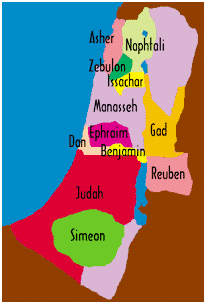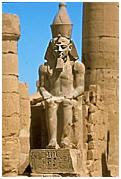有沒有關於以色列的族長,雅各兒子們的考古學證據?
作者﹕Dr.
Bryant G. Wood of
Associates for Biblical Research
張逸萍譯自﹕http://www.christiananswers.net/q-abr/abr-a028.html
|
|
|
|
以色列十二支派
(Films
for Christ.
提供的地圖) |
有各種考古發現,支持聖經所講,關於雅各的12個兒子,和以色列支派後來的記載。
但——必判斷他的民
見﹕創四十九16
但,是雅各的第五個兒子,是拉結的使女辟拉的第一個兒子(創三十1-6)。在士師時代,但支派從原先分配給他們的,地中海沿岸的之地,遷移到拉億,起名為但(士十八)。[1]
拉億 /
但的遺址,自1966年以來,由Avraham
Biran領導,代表以色列文物局,一直在挖掘。
但城最有名的地方是﹕這是北國第一位王耶羅波安,為了脫離南國,而設立拜金牛犢的丘壇地點之一。
耶羅波安王就籌畫定妥,鑄造了兩個金牛犢,對眾民說,以色列人哪,你們上耶路撒冷去,實在是難,這就是領你們出埃及地的神。他就把牛犢一隻安在伯特利,一隻安在但。
—王上十二28-29
這個丘壇已被Biran發現和挖掘(Biran
1976)。但的丘壇不僅在以色列時期使用,而且繼續到羅馬統治時期,仍然是宗教中心。
1977年,出現了一個非常重要的希臘化時期(主前3
- 2世紀)發現﹕在丘壇以南17米處,發現了一個專門提到但的碑文(Biran
1981)。這是第一次,聖經地名,在一個古老的銘文上找到,而且是雅各兒子之一的名字。
迦得——必被敵軍追逼
見﹕創四十九19
迦得是雅各的第七個兒子,是利拉的婢女悉帕的第一個兒子。迦得支派佔領了外約旦的中央地區(書十三24-28)。
在約旦Dhibon發現的,可追溯到主前9世紀的,著名米沙(Mesha)碑文,提到迦得支派。[2]摩押王米沙說:“迦得人自古就住在亞他錄地。”(Lemaire,1994:
33,第10行)。[3]
亞設——必出肥美的糧食
見﹕創四十九20
許多學者認為,在埃及文獻中的名字「'Isr」,就是以色列支派亞設這名字(例如,Aharoni
1979:179,183; Hadley 1992:482)。不過,似乎不是這樣。因此,我們根據從其他來源所得的資料,提出下面的意見。
最早提到「'Isr」這名字的,是主前13世紀,Seti一世所征服的人民名單上(Simons
1937:147, List XVII, no. 4)。
|
|
|
|
法老拉美西斯二世 (Films for Christ.提供) |
這個名字也出現在拉美西斯(Rameses)二世碑文上幾次(主前1279-1212年)也是在被征服的人民的名單中(Gauthier
1925:105; Kitchen 1993:39-40; Simons 1937: 162, List XXV, no. 8)。
也許最有趣的是主前13世紀末的安娜斯塔西莎草紙(Papyrus
Anastasi)。在其中,聰明的文士Hori,因為新手文士Amen-em-Opet對迦南的知識,而責罵他。他警告說,他的聲譽可能低至“當Asru('Isr)王,Qazardi,被一隻鬣狗撞見他爬上樹”
(Kitchen 1993:
40)。
請看埃及學家Kenneth
Kitchen,列出的四個原因,說明為什麼埃及名字“'Isr”不可能是以色列支派亞設(1993:
40-41; cf. Kitchen 1966: 70-71)﹕
§
文字中的「'Isr」是領土或一塊地的名字,而不是一個支派。
§
埃及字最後的“r”可以代表“l”或“r”。
§
不知道「'Isr」在哪裡,所以不可能將「'Isr」和亞設之間,建立地理上的聯繫。
§
埃及字母“s”相當於「th」,不是亞設(Asher)中的「sh」。
猶大——王的圭和杖必不離他
見﹕創四十九10
猶大也許是雅各的兒子中最著名的。他是雅各的第四個兒子,也是利亞所生的第四個兒子(創二十九35)。猶大的兄弟想殺約瑟,他勸阻了他們,並把他賣給以實瑪利的商人(創三十七26-27);在他們第二次因為飢荒到埃及,面對約瑟時,猶大是兄弟們的發言人(創四十三3;四十四14-34);由於他的三個哥哥被略過,[4]猶大繼承了雅各長子的位置,並得到雅各的適合君王的祝福(創四十九8-12)。
猶大所建立的支派,成為以色列支派中最偉大的。它得到應許地中最大的分派(書十五);彌賽亞也是從猶大而來(創四十九10-12;太一1-17;路三23-38);當國土分裂時,南國也簡稱為猶大;從巴比倫被擄回來以後,這古老的支派繼續被稱為Yehud
/ Judah / Judea,直到公元135年,Hadrian鎮壓了Bar
Khokba領導的反叛。之後,該名稱不再被使用。
由於幾個世紀以來,猶太地區在政治上的重要性,這個名字已經在許多古老的碑文中出現。
其中最古老的是,從主前八世紀起,有兩次提到猶大王亞哈斯﹕一次在教宗訓諭上所蓋之圓璽(粘土封印)上,寫著“亞哈斯,猶大王約坦的兒子”(Shanks
1997);另一次是在伊拉克的迦拉(Calah
,Nimrud),亞述國王Tiglath-pileser
III的建築的碑文上,它簡單地說,猶大王“亞哈斯(Jehoahaz
,Ahaz)”讚揚亞述王(Oppenheim
1969:282)。
在整個亞述時期,對猶大還有多次的被提到(Oppenheim
1969: 287, 288, 291, 294, 301)﹕主前597年,巴比倫人記錄了“猶大之城”被尼布甲尼撒王攻陷(Oppenheim
1969: 564),並向猶太俘虜,包括約雅敬,發放口糧(Oppenheim
1969: 308);此外,我們有
Elephantine,在主前407年,寫給猶太統治者Bagoas的信(Ginsburg
1969:492);主前4世紀的猶大硬幣,和主前4
- 2世紀的猶大封印(Stern 1982: 224-27;
202-13)。
所有這些資料,都支持了關於雅各、他的12個兒子、和以色列的後來支派的聖經記錄的歷史性。甚至有證據表明他們在埃及逗留。
更多資料
有沒有證據表明以色列人曾經住在埃及,正如聖經所說的那樣?還有,約瑟的原墓被找到了嗎?答案。
註釋
1.
For archaeological evidence for the migration of
the Danites, see Wood 1991:107-109.
2.
For more information on the Mesha Inscription,
see Wood 1996.
3.
Ataroth is thought to be located at Atarus 13 km
northwest of Dhiban.
4.
Reuben sleeping with his father's concubine
Bilhah (Gn 35:22), and Simeon and Levi massacring the men of Shechem
(Genesis 34).
參考書
·
Aharoni, Y. 1979 The Land of the Bible, rev. ed.,
trans. and ed. A.F. Rainey. Philadelphia: The Westminster Press.
·
Aling, C.F. 1996 The Historicity of the Joseph
Story. Bible and Spade 9: 17-28.
·
Bietak, M. 1986 Avaris and Piramesse:
Archaeological Exploration in the Eastern Nile Delta. London: The
British Academy. 1991a Der Friedhof in einem Palastgarten aus der Zeit
des spten Mittleren Riches und andere Forschungsergebnisse aus dem
stlichen Nildelta (Tell el-Daba 1984-1987). Agypten und Levante
2:47-109. 1991b Egypt and Canaan During the Middle Bronze Age. Bulletin
of the American Schools of Oriental Research 281: 27-72. 1996 Avaris:
The Capital of the Hyksos. London: British Museum Press.
·
Biran, A. 1976 City of the Golden Calf. Bible and
Spade 5:22-27. 1981 To the God Who is in Dan. Pp. 142-51 in Temples and
High Places in Biblical Times, ed. A. Biran. Jerusalem: Hebrew Union
College.
·
Chambon, A. 1984 Tell el-Far'ah I: L'ge du Fer.
Mmoire 31. Paris: Editions Recherche sur les Civilisations.
·
Finkelstein, I. 1986 Izbet Sartah: An Early Iron
Age Site Near Rosh Haayin, Israel. BAR International Series 299. Oxford:
B.A.R.
·
Fritz, V., and Kempinski, A. 1983 Ergebnisse der
Ausgrabunden auf der Hiebet el-Msas (Tel Masos) 1972-1975. Wiesbaden:
Otto Harrassowitz.
·
Gardiner, A. 1961 Egypt of the Pharaohs. London:
Oxford University Press. Gauthier, H. 1925 Dictionnaire des noms
goraphiques contenus dans les textes hiroglyphiques, vol. 1. Cairo:
L'Institute Franais d'Archologie Orientale.
·
Ginsberg, H.L. 1969 Aramaic Letters. Pp. 491-92
in Ancient Near Eastern Texts Relating to the Old Testament, ed. J.B.
Pritchard. Princeton: Princeton University Press.
·
Hadley, D.V. 1992 Asher. Pp. 482-83 in The Anchor
Bible Dictionary, vol. 1, ed. D.N. Freedman. New York: Doubleday.
·
Holladay, J.S., Jr. 1992a House, Israelite. Pp.
308-18 in The Anchor Bible Dictionary, vol. 3, ed. D.N. Freedman. New
York: Doubleday. 1992b Maskhuta, Tell el-. Pp. 588-92 in The Anchor
Bible Dictionary, vol. 4, ed. D.N. Freedman. New York: Doubleday. 1997
Maskhuta, Tell el-. Pp. 432-37 in The Oxford Encyclopedia of Archaeology
in the Near East, vol. 3, ed. E.M. Meyers. New York: Oxford University
Press.
·
Kitchen, K.A. 1966 Ancient Orient and Old
Testament. Downers Grove IL: InterVarsity. 1993 Ramesside Inscriptions
Translated and Annotated: Notes and Comments, vol. 1. Oxford: Blackwell.
·
Lemaire, A. 1994 House of David Restored in
Moabite Inscription. Biblical Archaeology Review 20/3: 30-37.
·
McCown, C.C. 1947 Tell en-Nasbeh I. Berkeley: The
Palestine Institute of Pacific School of Religion.
·
Oppenheim, A.L. 1969 Babylonian and Assyrian
Historical Texts. Pp. 265-317 and 556-67 in Ancient Near Eastern Texts
Relating to the Old Testament, ed. J.B. Pritchard. Princeton: Princeton
University Press.
·
Redford, D.B. 1992 Hyksos: History. Pp. 341-44 in
The Anchor Bible Dictionary, vol. 3, ed, D.N. Freedman. New York:
Doubleday.
·
Rohl, D.M. 1995 Pharaohs and Kings: A Biblical
Quest. New York: Crown. Shanks, H. 1997 Strata. Biblical Archaeology
Review 23/2: 8.
·
Shea, W.H. 1990 Leaving Egypt. Archaeology and
Biblical Research 3: 99-111.
·
Stern, E. 1982 Material Culture of the Land of
the Bible in the Persian Period 538-332 B.C. Warminster: Aris &
Phillips.
·
Ward, W.A. 1984 Royal-Name Scarabs. Pp. 151-192
in Studies on Scarab Seals, vol. 2, by Olga Tufnell. Warminster: Aris &
Phillips.
·
Wente, E., and Van Siclen III, C. 1977 A
Chronology of the New Kingdom. Pp. 217-61 in Studies in Honor of George
R. Hughes January 12, 1977, ed. J.H. Johnson and E.F. Wente. Studies in
Ancient Oriental Civilization 39. Chicago: The Oriental Institute.
·
Wood, B.G. 1991 Recent Discoveries and Research
on the Conquest. Archaeology and Biblical Research 4: 104-110. 1996
Mesha, King of Moab. Bible and Spade 9: 55-64.
·
Wright, G.E. 1965 Shechem: The Biography of a
Biblical City. London: Gerald Duckworth.
作者﹕Author: Dr. Bryant G. Wood of
Associates for Biblical
Research. Adapted from the ABR article: “The Sons of Jacob: New
Evidence for the Presence of the Israelites in Egypt”
Copyright © 1998, Associates for Biblical
Research, All Rights Reserved - **except as noted on attached “Usage and
Copyright” page that grants ChristianAnswers.Net users generous rights
for putting this page to work in their homes, personal witnessing,
churches and schools.
ChristianAnswers.Net Christian Answers Network
PO Box 1167 Marysville WA 98270-1167 USA
ChristianAnswers.Net
Christian Answers Network
PO Box 1167
Marysville WA 98270-1167

